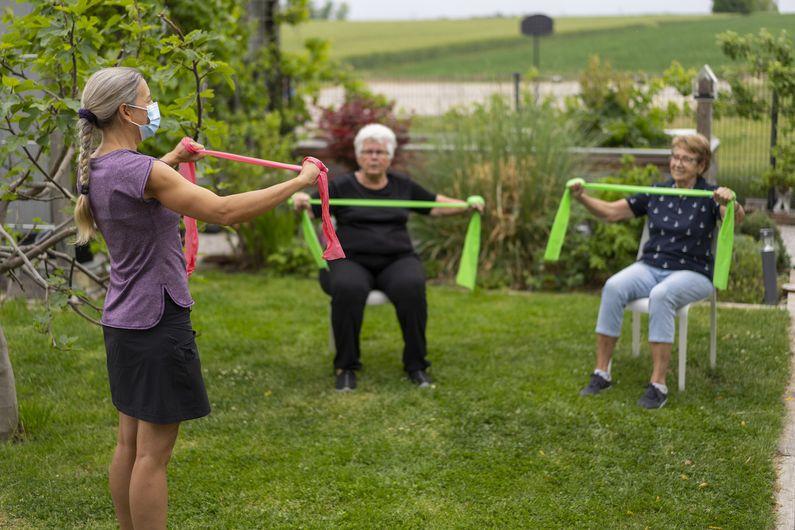Overcoming ‘leaky bladder’ in groups
- Salle de presse
08/10/2020
- UdeMNouvelles
For older women, getting physiotherapy for their pelvic floors in a group setting is as effective — and less expensive —in reducing urine leakage than one-on-one sessions, a new study finds.
More than 55 per cent of women age 60 and over suffer from urinary incontinence, or ‘leaky bladder,’ a serious condition that limits their daily activities and increases their risk of isolation and leading a sedentary lifestyle.
But there’s a way to prevent it: pelvic floor physiotherapy.
Now a large Quebec study published in JAMA Internal Medicine shows that physiotherapy in groups of eight is as effective as standard individual physiotherapy to treat urinary incontinence in older women.
The study was led by Université de Montréal physiotherapy professor Chantale Dumoulin, a researcher at the Research Centre of the Institut universitaire de gériatrie de Montréal of the CIUSSS du Centre-Sud-de-l'Île-de-Montréal.
Nearly three-quarters of the 362 participants in the study had a significant decrease in urine leakage after intensive physiotherapy lasting three months, a little moreso when the therapy was given in groups.
"Group physiotherapy had benefits that went beyond the therapeutic treatment itself,” said Dumoulin, who teaches at UdeM’s School of Rehabilitation and holds the Canada Research Chair in Urogynecological Health and Aging.
“The groups became a safe space for discussion and participants could talk without feeling embarrassed and exchange tips," she said.
In short, group training allowed participants to no longer feel alone when facing this health problem, which can be considered taboo.
Weekly one-hour sessions
From 2013 to 2018, 362 women participated in a one-year pelvic-floor physiotherapy program, supervised by a specialised physiotherapist, which consisted of weekly one-hour sessions over three months and exercises at home.
After learning how to contract their pelvic floor muscles in an individual session, half of the participants were assigned the standard treatment (individual physiotherapy) and the other half received the same treatment in a group of eight women (the GROUP program).
After 12 weeks of intensive treatment, the participants continued their exercises at home. One year after the start of the treatment, the researchers evaluated the percentage reduction in leakage episodes, recorded in a 7-day bladder diary.
Less leakage, and not as severe
The results of the study showed that after one year, urine leakage episodes were reduced by 70 per cent for participants who received the individual treatment and 74 per cent for those receiving the group treatment.
The amount of urine leakage, the severity of urinary symptoms and their impact on quality of life, and the number of day and night-time micturition were significantly reduced for both treatment groups.
For each of these measurements, the difference between the two treatments was not significant, indicating that group pelvic floor physiotherapy is as effective as the standard individual treatment.
Individual therapy more expensive
Individual physiotherapy treatment is more expensive. In many countries, it is not widely available, due to the lack of specialized physiotherapists. That makes group training approach more attractive – and effective, Dumoulin said.
“It could allow more women to be treated with limited human and financial resources, with a ratio of eight patients to one physiotherapist rather than one-on-one, without compromising the effectiveness of the treatment,” she said.
"Increasing the accessibility of physiotherapy could delay or even reduce surgical interventions to treat this condition while improving the quality of life of thousands of women," she concluded.
About this study
“Group-based versus individual pelvic floor muscle training to treat urinary incontinence in older women,” by Chantale Dumoulin et al, was published Aug. 3, 2020 in JAMA Internal Medicine. The research project received financial support from the Canadian Institutes of Health Research (CIHR) (MSH-258993) and the statistical analyses also received partial support from CIHR (PJT-148946). Chantale Dumoulin holds a Canada Research Chair Tier II Salary Award; her Incontinence and Aging Research Laboratory is supported by the Canada Foundation for Innovation.
Media contact
-
Jeff Heinrich
Université de Montréal
Tel: 514 343-7593














